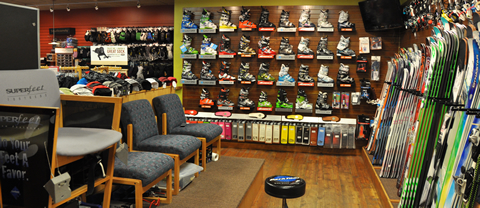
Diamond Peak has a certified pedorthist on staff for those who need special care when it comes to boot fitting. If your feet ache while skiing, or if you find yourself always adjusting your boots on the lift or at the bottom of the run, you need to consider custom boot fitting from our professional boot fitting technicians.
- Top-quality ski, run, and cycling orthotics
- Stance alignment and boot sole planing
- Guided ski boot selection and consultation
Making custom footbeds and modifications to the hard plastic shell are the foundations of custom boot fitting. Custom footbeds stabilize and balance the foot, while modifying the shell with heat or grinding allows it to take the shape of the skier’s foot and eliminates “hot spots” or pressure points.
Customized Boot Fitting specializing in Superfeet Insoles
Every skier, regardless of ability or experience level, can benefit from having a custom footbed made for them. Custom footbeds are molded to your foot by taking an impression of it, then placing the heated footbed in the mold with your foot on top. The process of molding a custom footbed typically takes between 30 and 60 minutes. Think of a footprint in wet sand which is unique to you and supports your entire foot evenly. A supported foot is stable, strong, balanced and relaxed, while an unsupported one is weak, unbalanced and easily fatigued. Much of the discomfort skiers experience is a result of an unsupported foot trying to stay balanced and working too hard to steer the ski through the turn. Proper footbeds are essential for an effective fit.
Cuff Alignment
Once a footbed is selected, the next step is to check the alignment of the upper cuff. Ideally, you should be able to stand in a natural stance and have the base of both skis neutral (flat) on the snow. Not all skiers require cuff alignment, and not all boots offer a cuff adjustment feature, but ask a boot fitter if you suspect that the natural alignment of your legs puts unequal pressure on either your inside or outside ski edges. Canting often confused with cuff alignment, canting refers to tilting or angling the entire ski boot laterally to achieve a neutral stance. This is done by either installing wedges under the bindings when the ski is mounted or planing the sole of the boot. Since this is not something that can be accurately done at home, canting should be left to a qualified boot fitter and shop with the right equipment.
Shell Modifications
When your bones are pressured by the hard plastic shell, you can expect problems. This is where shell modification comes into play. Modifying the shell to match the shape of your foot can be done by grinding the plastic away or by heating and reshaping the plastic with an assortment of specialized tools (also known as “punching” the boot). Common situations that call for modifying the boot shell include bunions, bone spurs, hardware from surgery or Morton’s toe (a condition where the second toe is significantly longer than the first).

